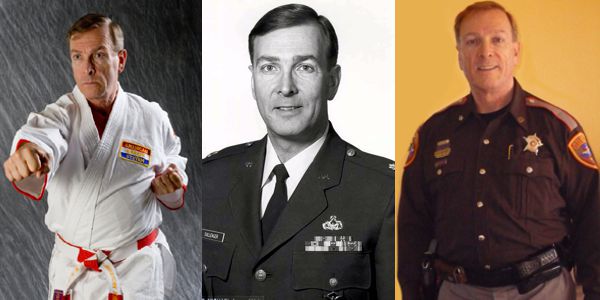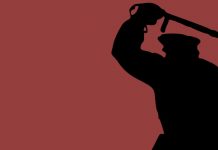Introduction
Police officers must use force when placing uncooperative subjects under arrest, as well as during situations of unrest (e.g. riots, protests where property is being destroyed, etc.). As the administrator in charge of the police department the chief must provide guidance on the application and intensity of his officer’s use of force. Chiefs accomplish this via written policy coupled with initial and continuing education and training.
But how does a chief go about discerning the best application of the use of force by his personnel? How does a chief decide what tools his officers will use when force is necessary, aside from the traditional side arm? These are crucial and necessary questions each chief of police must address and answer. As we look at the use of force we’ll see how limitations – in tools and/or training – have an affect on an officer’s ability to properly deal with hostile and uncooperative subjects.
The Tools of Force
By “tools” we mean what an officer is provided with to meet and overcome an opposing individual or force. If we look at the first line of opposition as being verbal, then an officer must be capable of talking his or her way out of a situation using their intelligence, common sense and command of the situation. One of the best training methods for this is Dr. George Thompson’s “Verbal Judo.” Here students learn how to deal with verbal confrontations while maintaining their professional demeanor. We all know how difficult it sometimes is for officers to not take things personally. Some officers have the gift of gab, while others need help in developing it.
If the officer fails to convince, or compel, the individual to cooperate, he must then be willing and capable of using empty hand techniques. Known as come-along tactics, officers use them to subdue the subject, with minimal physical injury to either party using joint locks, leverage and pressure points to gain the advantage.
The next level of force available to officers involves chemical products. These agents come in the form of aerosols and projectiles or canisters – gas grenades. The most effective are the current brand of chemical pepper sprays carried by officers. The incapacitation of pepper spray on a subject makes it easier for an officer to take a subject into custody without being injured, and with little to know injury or damage to the subject himself.
As the use of force escalates we come to the impact weapons (night sticks, side handle batons – PR 24 – and expandable batons). This is the last level of force available to police that is considered to be at the non-lethal stage. This latter statement is misleading because any of the impact weapons named can cause death when improperly used. Additionally, the use of impact weapons results in physical trauma to the suspect. This trauma may be as slight as bruising, too as severe as broken bones.
Lastly, we have the officer’s side arm. The type and caliber used by officers across the country today varies from 38s to 45s, and between revolvers and semi-automatics. Chiefs have their rationale for the choices they’ve made regarding the firearm they allow their department’s personnel to carry. The use of a firearm (when fired and the subject is hit) normally results in death. This is the highest and most extreme level in the use of force compendium.
Training
Now that we’ve set the stage with the above discussion on the various tools available to police officer for use in use of force situations, we must talk about the type and level of training officers receive with these items. Regardless of which of the above mentioned tools a chief allows his personnel to carry on duty, those tools are only as good as the training provided to the officers. In this discussion administrators must understand the importance of ensuring their officers receive initial and continuing training with the tools they’re provided. Whether we speak of the abilities learned through verbal judo training, or impact weapons, the key point is this; the training must be to the extent that officers become both competent and confident in their application and use. This requires both determination and dedication on the part of the department and its personnel.
In various “shoot, don’t shoot” scenarios, used with computer simulators, officers are confronted with an assailant brandishing a club, or in one case a crow bar. If the officer fails to shoot this individual he or she has failed to take the proper response, according to the designer of the training program. Yet, some officers, who’ve taken martial arts classes on their own volition, can articulate to the instructors why they didn’t need to shoot. Why do we fail to provide the necessary level of training with non-lethal techniques and tools? Why must officers who take their safety, as well as their profession, seriously enough to get the training on their own do so?
In some cases, chiefs do not understand the importance of the various types of training. They’ve come from the old school of hard knocks. If the department doesn’t provide it why should I do it on my own? In other cases the department’s budget makes it difficult for the chief to justify the expense for the training and/or the equipment. Or it may be a combination of both of these reasons. Regardless of the reason, chiefs owe it to their personnel to provide each of their officers with every tool available, along with the initial and ongoing training that results in an officers competence and self-confidence to use of assigned tools without hesitation.
Liability
There’s another reason why it behooves department heads to provide their personnel with both the tools and the training to accomplish the arrest and detention of suspects with minimal force. If a department provides only a side arm to its officers, and little to no training in use of force tactics after the academy, the officer has little choice but to resort to the use of his side arm at a much earlier stage in a situation. Officers who lack the competence and self-confidence to use hand-to-hand techniques, or even the gift of gab, resort quickly to the one thing they do have confidence in, their pistol.
In today’s society the potential for civil litigation against a department for failure to provide either the tools and/or the training can result in court decisions in favor of the complainants. The cost of providing both the tools and the training may be tough for some departments. The hindsight that results from the anguish and worry of a lawsuit, however, offsets this expense. This is even truer when the suit is lost because the complainant had a strong standing. The department that provides the tools and training (coupled with sound well thought out policies) will face fewer lawsuits. This is because opposing lawyers will find it difficult at best to provide enough grounds on which to file a suit.
Summary
The morale of this story is simple. Provide officers with the tools to get the job done. Along with the tools must come training that develops and maintains both competence and self-confidences in the application and use of those tools. Lastly, ensure policies exist that provides officers with the guidance for the application and use of their respective tools. There is no such thing as an overly prepared and trained police officer. All to often the opposite is the case.






